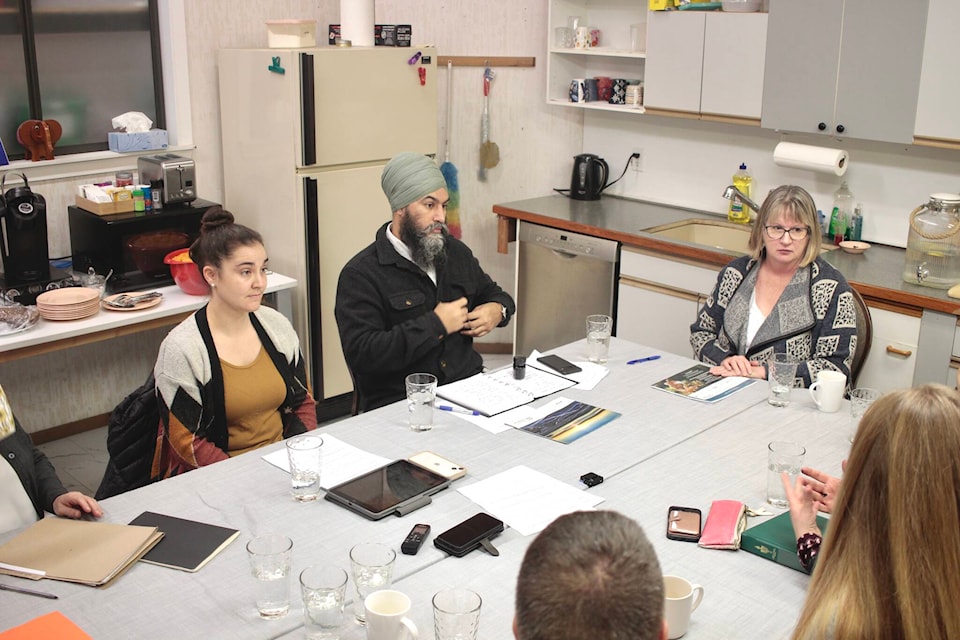Last year, the number of people who used the Campbell River Food Bank went up by ten per cent.
In 2021, there were 2,403 unique individuals, be they children, adults or seniors, who used the Campbell River Food Bank. The next year, that same number was 2,653. That is 250 more people than last year. That count includes people who come to the food bank regularly, as well as those who only visit one or twice per year. Regardless, each person in the count was counted once, so there was no duplication in that number.
“Some of the first timers who come have tears in their eyes,” said Bob Naylor, a volunteer who has worked at the food bank for years.
Those numbers aren’t unique to Campbell River. Food bank use is up across the country, with 60 per cent more Canadians per month expected to use food banks and other programs this year, according to a Jan. 11 survey by Second Harvest.
Admist this, federal NDP leader Jagmeet Singh visited the Campbell River Food Bank to meet with local non-profit representatives who are working to lessen the blows of the cost of living crisis for regular Campbell Riverites.
Singh met with Stefanie Hendrickson from the Campbell River and District Coalition to End Homelessness, Michaela Arruda from the Campbell River Community Foundation, Ian Baikie from Hama?Elas Community Kitchen, Tanille Johnston from the City of Campbell River and Jo Watson from the Campbell River Food Bank to discuss how things actually look on the ground for real people in affected communities.
“We really want to just hear from you. I want to hear from you,” Singh said at the roundtable. “Hearing from you will help us come up with maybe … real direct ways to help people out.”
Food Security
Watson was the first to share, telling Singh that the food bank’s major concern was that it no longer had the space to meet the growing demand.
“Food banks in general are not recognized as an ‘essential service,’” she said. “But the individuals that we serve sure think we are.”
A bigger facility for food security purposes was on other minds as well. Baikie said that the Hama?Elas Community Kitchen could stand to have an expanded space, with a second kitchen to prepare more than one meal per day. Hama?Elas, which uses the food bank for 85 per cent of its food, serves an average of 75 people per night. Baikie said that “we’re not in the right facility.”
“If we shared kitchens for food recovery and for education and we had multiple kitchen opportunities so that we could create lunch and one kitchen while dinner is being created in the other some days, that would be much better,” he said.
The thing is, that costs money. Part of what Singh and North Island-Powell River MP Rachel Blaney can do is advocate for adjustments to federal grant programs, including providing continuing funding to keep intiatives created during the early years of the pandemic afloat.
“Our funding hits a cliff in July where COVID funding runs away from us, and there’s no operating budget operating grants available in the system. So our 100,000 a year that we spend to operate is unfunded as of Aug. 1,” Baikie said. “The grants aren’t there for that, and that’s scaring the daylights out of me right now.”
To Johnston, a facility that would combine housing and food security projects would be ideal. She told Singh that there were projects for housing already, but without the supports there for people who needed them, these projects would not meet their potential.
”Thousands of people moved into Merecroft Village in those complexes. Did we do anything to support them? Did we get more groceries? Did we put more buses? Did we add more medical facilities? Do we have more daycare spots? Absolutely not,” she said. “We can’t just build housing. We have to build everything that’s going to support people that are those houses.”
Housing
Funding to make housing more affordable comes from a variety of sources, including municipal, provincial and federal governments. However, Hendrickson said that she has noticed a treatment of symptoms, not causes across the board.
”Nonprofits are sort of put in a position of picking up the pieces where the social determinants of health are being failed by the government,” she said. “That’s where we’re seeing shortcomings.”
Those shortcomings are a lack of different types of housing, wages not keeping up with the cost of housing, disability rates not keeping up with the cost of shelter, employers not being able to attract employees because of a lack of housing, and administrative barriers for non profits who are trying to apply for federal funding.
“This is affecting the ability of all sectors to move forward,” she said. “We’re finding that the funding that’s being built with CMHC (Canada Mortgage and Housing Corporation) funding is not actually the level of deeply affordable housing that’s needed. So it’s it’s ‘affordable’, but it’s not affordable.
“We need to stick with those definitions of affordability that we have and then actually be funding things that are meeting those definitions.”
Johnston agreed, saying “the definition of ‘affordability’ really gets us sometimes. It’s not affordable … when I think of affordability for someone that needs a home, it’s $375 a month … That is what someone can afford to pay for rent … not $1,200 a month for a bachelor, if you could even find that right now.”
“What I get out of these conversations every single time as we have to stop putting Band-Aids on the wounds and start actually preventing the wounds from happening,” Singh said to end the discussion.
RELATED: Federal NDP leader visits Campbell River to discuss affordability, housing and food security
marc.kitteringham@campbellrivermirror.com
Like us on Facebook and follow us on Twitter
